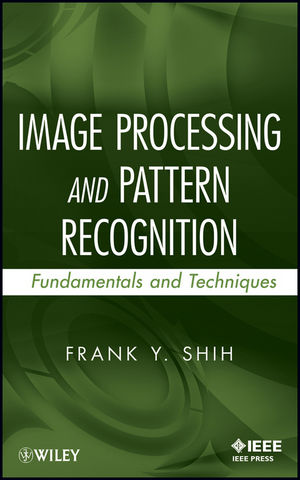Image Processing and Pattern Recognition: Fundamentals and TechniquesISBN: 978-0-470-40461-4
552 pages
May 2010, Wiley-IEEE Press
|
Description
Techniques and applications in the areas of image processing and pattern recognition are growing at an unprecedented rate. Containing the latest state-of-the-art developments in the field, Image Processing and Pattern Recognition presents clear explanations of the fundamentals as well as the most recent applications. It explains the essential principles so readers will not only be able to easily implement the algorithms and techniques, but also lead themselves to discover new problems and applications.
Unlike other books on the subject, this volume presents numerous fundamental and advanced image processing algorithms and pattern recognition techniques to illustrate the framework. Scores of graphs and examples, technical assistance, and practical tools illustrate the basic principles and help simplify the problems, allowing students as well as professionals to easily grasp even complicated theories. It also features unique coverage of the most interesting developments and updated techniques, such as image watermarking, digital steganography, document processing and classification, solar image processing and event classification, 3-D Euclidean distance transformation, shortest path planning, soft morphology, recursive morphology, regulated morphology, and sweep morphology. Additional topics include enhancement and segmentation techniques, active learning, feature extraction, neural networks, and fuzzy logic.
Featuring supplemental materials for instructors and students, Image Processing and Pattern Recognition is designed for undergraduate seniors and graduate students, engineering and scientific researchers, and professionals who work in signal processing, image processing, pattern recognition, information security, document processing, multimedia systems, and solar physics.
Table of Contents
1 INTRODUCTION.
1.1 The World of Signals.
1.2 Digital Image Processing.
1.3 Elements of an Image Processing System.
Appendix 1.A Selected List of Books on Image Processing and Computer Vision from Year 2000.
References.
2 MATHEMATICAL PRELIMINARIES.
2.1 Laplace Transform.
2.2 Fourier Transform.
2.3 Z-Transform.
2.4 Cosine Transform.
2.5 Wavelet Transform.
3 IMAGE ENHANCEMENT.
3.1 Grayscale Transformation.
3.2 Piecewise Linear Transformation.
3.3 Bit Plane Slicing.
3.4 Histogram Equalization.
3.5 Histogram Specification.
3.6 Enhancement by Arithmetic Operations.
3.7 Smoothing Filter.
3.8 Sharpening Filter.
3.9 Image Blur Types and Quality Measures.
4 MATHEMATICAL MORPHOLOGY.
4.1 Binary Morphology.
4.2 Opening and Closing.
4.3 Hit-or-Miss Transform.
4.4 Grayscale Morphology.
4.5 Basic Morphological Algorithms.
4.6 Morphological Filters.
5 IMAGE SEGMENTATION.
5.1 Thresholding.
5.2 Object (Component) Labeling.
5.3 Locating Object Contours by the Snake Model.
5.4 Edge Operators.
5.5 Edge Linking by Adaptive Mathematical Morphology.
5.6 Automatic Seeded Region Growing.
5.7 A Top-Down Region Dividing Approach.
6 DISTANCE TRANSFORMATION AND SHORTEST PATH PLANNING.
6.1 General Concept.
6.2 Distance Transformation by Mathematical Morphology.
6.3 Approximation of Euclidean Distance.
6.4 Decomposition of Distance Structuring Element.
6.5 The 3D Euclidean Distance.
6.6 The Acquiring Approaches.
6.7 The Deriving Approaches.
6.8 The Shortest Path Planning.
6.9 Forward and Backward Chain Codes for Motion Planning.
6.10 A Few Examples.
7 IMAGE REPRESENTATION AND DESCRIPTION.
7.1 Run-Length Coding.
7.2 Binary Tree and Quadtree.
7.3 Contour Representation.
7.4 Skeletonization by Thinning.
7.5 Medial Axis Transformation.
7.6 Object Representation and Tolerance.
8 FEATURE EXTRACTION.
8.1 Fourier Descriptor and Moment Invariants.
8.2 Shape Number and Hierarchical Features.
8.3 Corner Detection.
8.4 Hough Transform.
8.5 Principal Component Analysis.
8.6 Linear Discriminate Analysis.
8.7 Feature Reduction in Input and Feature Spaces.
9 PATTERN RECOGNITION.
9.1 The Unsupervised Clustering Algorithm.
9.2 Bayes Classifier.
9.3 Support Vector Machine.
9.4 Neural Networks.
9.5 The Adaptive Resonance Theory Network.
9.6 Fuzzy Sets in Image Analysis.
PART II: APPLICATIONS.
10 FACE IMAGE PROCESSING AND ANALYSIS.
10.1 Face and Facial Feature Extraction.
10.2 Extraction of Head and Face Boundaries and Facial Features.
10.3 Recognizing Facial Action Units.
10.4 Facial Expression Recognition in JAFFE Database.
11 DOCUMENT IMAGE PROCESSING AND CLASSIFICATION.
11.1 Block Segmentation and Classification.
11.2 Rule-Based Character Recognition System.
11.3 Logo Identification.
11.4 Fuzzy Typographical Analysis for Character Preclassification.
11.5 Fuzzy Model for Character Classification.
12 IMAGE WATERMARKING.
12.1 Watermarking Classification.
12.2 Spatial Domain Watermarking.
12.3 Frequency-Domain Watermarking.
12.4 Fragile Watermark.
12.5 Robust Watermark.
12.6 Combinational Domain Digital Watermarking.
13 IMAGE STEGANOGRAPHY.
13.1 Types of Steganography.
13.2 Applications of Steganography.
13.3 Embedding Security and Imperceptibility.
13.4 Examples of Steganography Software.
13.5 Genetic Algorithm-Based Steganography.
14 SOLAR IMAGE PROCESSING AND ANALYSIS.
14.1 Automatic Extraction of Filaments.
14.2 Solar Flare Detection.
14.3 Solar Corona Mass Ejection Detection.
INDEX.










